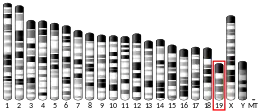CBWD1
COBW domain-containing protein 1 is a protein that is found in humans and mice. It is encoded by the CBWD1 gene.[5][6][7]
| CBWD1 | |||||||||||||||||||||||||
|---|---|---|---|---|---|---|---|---|---|---|---|---|---|---|---|---|---|---|---|---|---|---|---|---|---|
| Identifiers | |||||||||||||||||||||||||
| Aliases | CBWD1, COBP, COBW domain containing 1 | ||||||||||||||||||||||||
| External IDs | OMIM: 611078 MGI: 2385089 HomoloGene: 6843 GeneCards: CBWD1 | ||||||||||||||||||||||||
| |||||||||||||||||||||||||
| |||||||||||||||||||||||||
| Orthologs | |||||||||||||||||||||||||
| Species | Human | Mouse | |||||||||||||||||||||||
| Entrez | |||||||||||||||||||||||||
| Ensembl | |||||||||||||||||||||||||
| UniProt | |||||||||||||||||||||||||
| RefSeq (mRNA) | |||||||||||||||||||||||||
| RefSeq (protein) | |||||||||||||||||||||||||
| Location (UCSC) | Chr 9: 0.12 – 0.18 Mb | Chr 19: 24.92 – 24.96 Mb | |||||||||||||||||||||||
| PubMed search | [3] | [4] | |||||||||||||||||||||||
| Wikidata | |||||||||||||||||||||||||
| |||||||||||||||||||||||||
References
- GRCh38: Ensembl release 89: ENSG00000172785 - Ensembl, May 2017
- GRCm38: Ensembl release 89: ENSMUSG00000024878 - Ensembl, May 2017
- "Human PubMed Reference:". National Center for Biotechnology Information, U.S. National Library of Medicine.
- "Mouse PubMed Reference:". National Center for Biotechnology Information, U.S. National Library of Medicine.
- Wong A, Vallender EJ, Heretis K, Ilkin Y, Lahn BT, Martin CL, Ledbetter DH (Jul 2004). "Diverse fates of paralogs following segmental duplication of telomeric genes". Genomics. 84 (2): 239–47. doi:10.1016/j.ygeno.2004.03.001. PMID 15233989.
- Fan Y, Newman T, Linardopoulou E, Trask BJ (Nov 2002). "Gene content and function of the ancestral chromosome fusion site in human chromosome 2q13-2q14.1 and paralogous regions". Genome Res. 12 (11): 1663–72. doi:10.1101/gr.338402. PMC 187549. PMID 12421752.
- "Entrez Gene: CBWD1 COBW domain containing 1".
External links
- Human CBWD1 genome location and CBWD1 gene details page in the UCSC Genome Browser.
Further reading
- Page N, Butlin D, Manyonda I, Lowry P (2000). "The development of a genetic profile of placental gene expression during the first trimester of pregnancy: a potential tool for identifying novel secreted markers". Fetal Diagn. Ther. 15 (4): 237–45. doi:10.1159/000021014. PMID 10867487. S2CID 24233825.
- Hu RM, Han ZG, Song HD, et al. (2000). "Gene expression profiling in the human hypothalamus-pituitary-adrenal axis and full-length cDNA cloning". Proc. Natl. Acad. Sci. U.S.A. 97 (17): 9543–8. doi:10.1073/pnas.160270997. PMC 16901. PMID 10931946.
- Shi J, Cai W, Chen X, et al. (2001). "Identification of dopamine responsive mRNAs in glial cells by suppression subtractive hybridization". Brain Res. 910 (1–2): 29–37. doi:10.1016/S0006-8993(01)02393-9. PMID 11489251. S2CID 43814085.
- Strausberg RL, Feingold EA, Grouse LH, et al. (2003). "Generation and initial analysis of more than 15,000 full-length human and mouse cDNA sequences". Proc. Natl. Acad. Sci. U.S.A. 99 (26): 16899–903. doi:10.1073/pnas.242603899. PMC 139241. PMID 12477932.
- Humphray SJ, Oliver K, Hunt AR, et al. (2004). "DNA sequence and analysis of human chromosome 9". Nature. 429 (6990): 369–74. doi:10.1038/nature02465. PMC 2734081. PMID 15164053.
- Gerhard DS, Wagner L, Feingold EA, et al. (2004). "The status, quality, and expansion of the NIH full-length cDNA project: the Mammalian Gene Collection (MGC)". Genome Res. 14 (10B): 2121–7. doi:10.1101/gr.2596504. PMC 528928. PMID 15489334.
- Ewing RM, Chu P, Elisma F, et al. (2007). "Large-scale mapping of human protein-protein interactions by mass spectrometry". Mol. Syst. Biol. 3 (1): 89. doi:10.1038/msb4100134. PMC 1847948. PMID 17353931.
This article is issued from Wikipedia. The text is licensed under Creative Commons - Attribution - Sharealike. Additional terms may apply for the media files.




